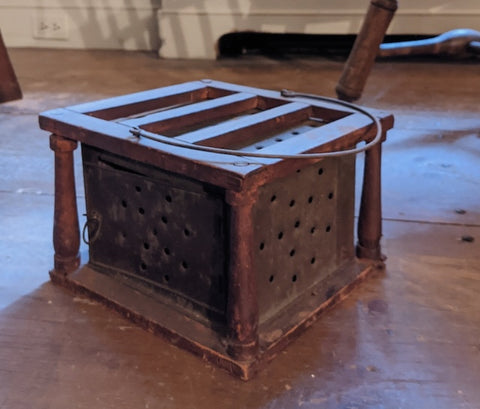
History Mystery #8 solution: Colonial-era "foot stove"
Ian LamontIt's time for the solution to last week's History Mystery. Many thanks to those readers who wrote in about the unusual object shown above. When I first saw it, I thought it was an early radio (wrong!) and was surprised to discover the truth.
Before I get to your answers, here’s another similar object, shown in the lower left corner of the haunting 1665 Jan Steen painting “Sick Woman”:

What could it be? Reader L.S. was inspired by a childhood experience:
“I believe this tin box with wood around it, called a scuttle, was used to carry hot coals from the fire generally from fireplace or coal and wood stove used for cooking. Growing up in rural Montana, a huge cooking coal and wood stove also provided heat for our tiny home. No matter the season, my mother would get out big metal tubs every Saturday and fire up that stove to heat the water to wash clothes and so we could have a nice warm bath.”
Close, but not quite! Other speculation included:
- “A portable nightlight powered with small candle, similar to our current plumber's candle.” - M.H.
- “Looks like it could have been a bread box.” - A.T.
- “Early bread toaster” - M.
- “It’s for polishing shoes.” - E.H.
- “Mousetrap!” - R.S.
The following image, from the Fraunces Tavern Museum in New York, gives another clue: slots with holes on the top of the device.

The correct answer came from several readers. S.B. said:
“It's a buggy foot warmer. 19th Century I believe. Made out of wood and tin. Hot coals go in the tin box.”
She was correct about the materials, but the device in the History Mystery picture at the top of this page was from the 1700s. Known as a foot warmer or foot stove, it could be used in many household situations. Here’s another correct answer, from R.S.:
“I believe the item was used as a portable heater. They would heat a brick or something that would retain the heat and then move it to where ever it was needed. I live in the Lancaster County area and some of our local Amish and Old Order Mennonites still use a similar method to heat their buggies.”
Foot stove history
Foot stove technology dates to the 16th century. This is a description from 1594 in London:
“The like device is used in conveying such iron pinns into hollow boxes of wood, first lined inwardly with metal, either to laye under their feete when they write, or studie, in cold weather, or in their caches to keep their feete warm.”
The Fraunces Tavern Museum, which has a foot stove in its collection, gives more details:
"Holes could be found both in the wood or metal, and usually appeared in patterns, such as hearts or geometric shapes. These holes allowed for ventilation to release the warmth from the coals. Women’s skirts or blankets were usually hung over the foot warmer to insulate the heat.”
Many thanks to everyone who responded!







